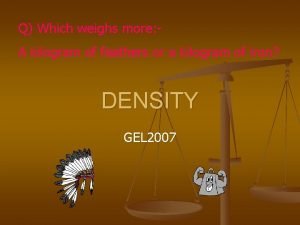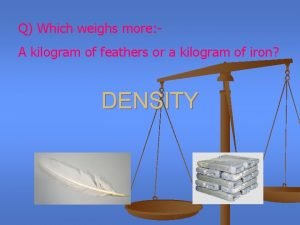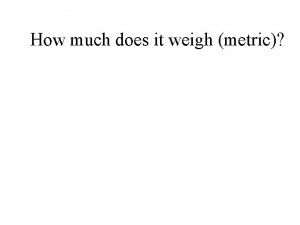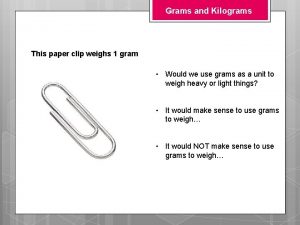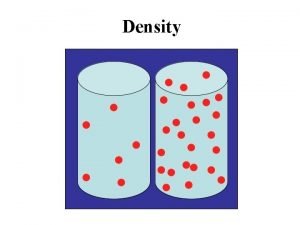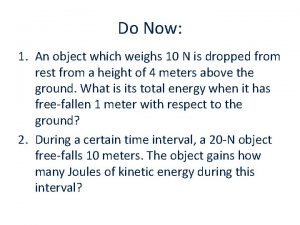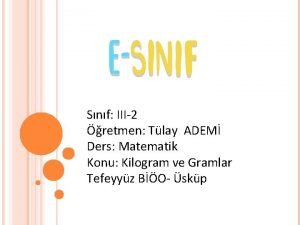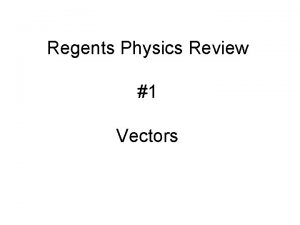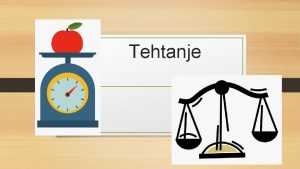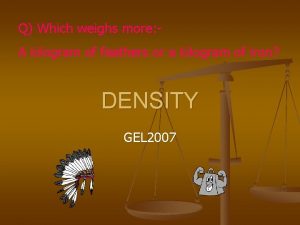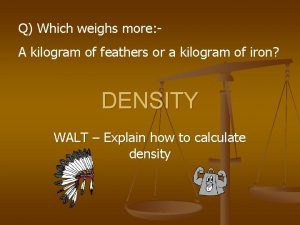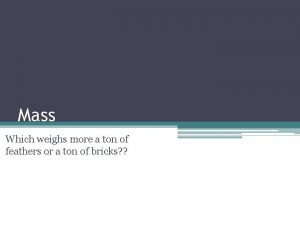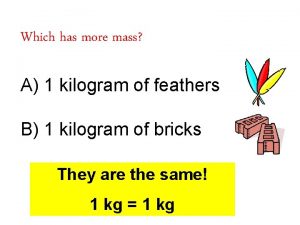Q Which weighs more A kilogram of feathers












- Slides: 12

Q) Which weighs more: A kilogram of feathers or a kilogram of iron? DENSITY GEL 2007

What is Density? If you take the same volume of different substances, then they will weigh different amounts. Wood Water Iron 1 cm 3 0. 50 g 1. 00 g 8. 00 g IRON Q) Which has the greatest mass and therefore the most dense? Density is the Mass per unit Volume

Density Equation: g or kg Density = Mass Volume m gcm-3 or kgm-3 cm 3 or kg 3 = m V V Example: Q) Liquid water has a density of 1000 kgm-3, while ice has density of 920 kgm-3. V = m = 0. 25 = 0. 000250 m 3 Calculate the volume occupied by 1000 0. 25 kg of each. 3 V = m = 0. 25 = 0. 000272 m 920

DENSITY OF A REGULAR SOLID m = 240 g 2. 0 cm 3. 0 cm = m = 240 =10. 0 g/cm 3 V 24 4. 0 cm Find the Mass of the solid on a balance. n Measure three lengths and calculate the Volume. (ie V = l x w x h ) n Calculate the Density. n

Material Mass in g Length in cm Width in cm Height in cm Volume in cm 3 Density in g/cm 3

DENSITY g/cm 3 Aluminium 2. 70 Iron 7. 86 Brass 8. 50 Wood Slate 0. 50 2. 80 Glass 2. 50 Lead Marble Wax 11. 3 2. 70 0. 89

DENSITY OF AN IRREGULAR SOLID m = 360 g 80 cm 3 50 cm 3 = m = 360 =12. 0 g/cm 3 V 30 n Find the Mass of the solid on a balance. n. Fill the Measuring Cylinder with Water to a known Volume. n Add the Object. n Work out the Volume of Water that is displaced. n Calculate the Density.

DENSITY OF AN IRREGULAR SOLID n OR use a Eureka Can to find the Volume. Find the mass of the solid on a balance. n. Add water until just overflowing. n Place a Measuring Cylinder under the spout. n Add the Object. n Collect the Water and read off the Volume. n. Calculate Density n m = 440 g 40. 0 cm 3 = m = 440 =11. 0 g/cm 3 V 40

DENSITY g/cm 3 Aluminium 2. 70 Iron 7. 86 Brass 8. 50 Wood 0. 50 Slate 2. 90 Glass 2. 50

Mass of Liquid = Mass of Measuring Cylinder and Liquid – Mass of DENSITY OFempty A LIQUID Measuring Cylinder n n n 25. 0 g 45. 0 20. 0 n cm 3 n n 45 – 25 = 20 g Find the Mass of an empty Measuring Cylinder. Add a certain Volume of Liquid. Find the Mass of the Measuring Cylinder and Liquid Calculate the Mass of Liquid. How? Calculate Density of Liquid. = m = 20 =1. 00 g/cm 3 V 20

Liquid Mass of empty Measuring Cylinder in g Mass of Measuring Cylinder and Liquid in g Mass of Liquid in g Volume in cm 3 Density in g/cm 3

DENSITY OF A GAS n To vacuum flask n 150. 0 170. 0 gg n 1000 cm 3 n 170 -150 = 20. 0 g = m = 20 =0. 0200 g/cm 3 V 1000 n n Remove the air from a flask of a known Volume, using a vacuum pump. Find its Mass. Add the gas to be tested. Reweigh. The difference is the Mass of gas. Calculate Density.
 Density of feathers
Density of feathers Compared to 8 kilograms of feathers
Compared to 8 kilograms of feathers More more more i want more more more more we praise you
More more more i want more more more more we praise you More more more i want more more more more we praise you
More more more i want more more more more we praise you What does 1 kg look like
What does 1 kg look like What weighs 1 gram
What weighs 1 gram Which weighs more
Which weighs more Horizontal
Horizontal Bir tabak pirincin kütlesi
Bir tabak pirincin kütlesi The diagram below represents a 155 newton box on a ramp
The diagram below represents a 155 newton box on a ramp Kilogram 2 titik perpuluhan
Kilogram 2 titik perpuluhan Koliko dekagramov je en kilogram
Koliko dekagramov je en kilogram Trappetje meters
Trappetje meters
